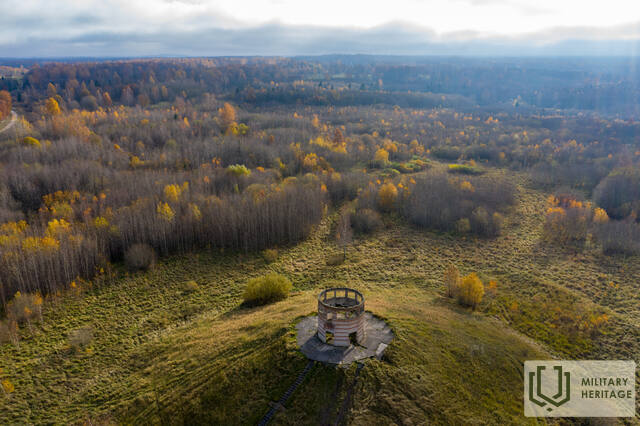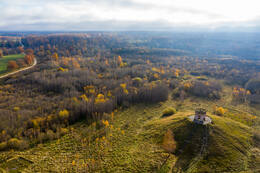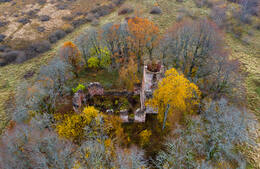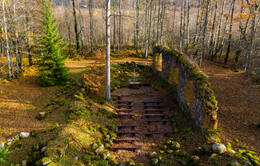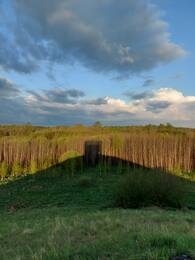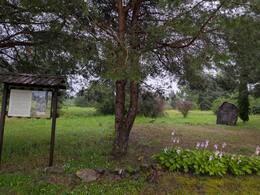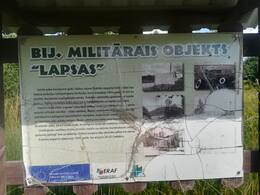Aviacijos bombardavimo poligonas
IV Sovietų okupacija
Specialiai paskirta ir įrengta sausumos, jūros ir oro erdvės teritorija, skirta SSRS karinių oro pajėgų dalinių, skyrių ir atskirų orlaivių įgulų taktiniams ir koviniams ginklų mokymams.
Susijusi laiko juosta
Susijusios vietos
Sovietų armijos apžvalgos bokštas (Karininkų kurganas)
„Karininkų kurganas“ yra mažiau nei už kilometro nuo Zvārdės bažnyčios griuvėsių. Kurganas sudarytas iš aplinkinių namų ir dvaro rūmų griuvėsių ir liekanų, kurios buvo suverstos buldozeriais. Ant kurgano pastatytas stebėjimo bokštas. Remiantis užrašu, dabartinis bokštas buvo pastatytas 1981 m. Bokštas buvo naudojamas bombų pataikymams registruoti. Mokomosiose bombose buvo sumažintas sprogstamosios medžiagos kiekis, todėl jų pataikymus reikėjo stebėti atidžiau. Nesprogusios bombos buvo nedelsiant neutralizuotos, tačiau ne visas pavyko rasti.
Šiandien čia galima pamatyti bokšto liekanas – plytų sienas. Kadangi užtvanka yra gana aukšta, giedrą dieną Mažeikiuose galima pamatyti net Lietuvos naftos perdirbimo gamyklą.
Ķerklinių bažnyčios griuvėsiai
Kerklinių bažnyčios griuvėsiai yra apie 5 kilometrus į šiaurės vakarus nuo Kokmuižos, netoli Kerklinių ežero. Bažnyčią 1641 m. pastatė Kerklinių dvaro savininkas Heinrichas fon Dönhoffas (Derkartas). Originali medinė bažnyčia buvo pakeista akmeniniu pastatu, po kuriuo buvo įrengti kapai Dönhofų, o vėliau Kleistų šeimų mirusiesiems. Kapai jau buvo sunaikinti per 1905 m. riaušes, tačiau 1949 m. karstai iš kapų buvo perkelti į bažnyčią. Bažnyčia buvo Kuržemės baroko stiliaus pavyzdys – jos drožinius sukūrė Kuldygos ir Liepojos medžio drožėjai. Nors dvaro ir bažnyčios savininkai įvairiais laikais susidūrė su finansinėmis problemomis, per savo gyvavimo laikotarpį bažnyčia buvo kelis kartus rekonstruota. Ji taip pat nukentėjo per Pirmąjį pasaulinį karą, po kurio parapija 1929 m. atstatė mūrą, o 1934 m. pridėjo vargonus. Deja, per Antrąjį pasaulinį karą bažnyčia buvo apgadinta ir didelė jos dalis buvo prarasta, todėl reikia pagirti, kad iki bažnyčios atstatymo 1933 m. daugelis unikalių baroko skulptūrų buvo nufotografuotos, suinventorizuota ir netgi atsidūrė Paminklų valdybos archyve. Įkūrus sąvartyną ir iškeldinus gyventojus, bažnyčia niekada nebuvo restauruota. Šiandien matomos bažnyčios sienos ir bokštas.
Žvėrių bažnyčios griuvėsiai
Zvārdės bažnyčios griuvėsiai yra buvusio Zvardės oro taikinių poligono teritorijoje, netoli vadinamojo „Karininkų kurgano“. Nuvažiavę pusantro kilometro, pravažiuosite T formos sankryžą su netoliese esančiomis Rītelių kapinėmis.
Pirmoji medinė bažnyčia ir klebonija čia buvo pastatytos 1567 m., o mūrinė bažnyčia – 1783 m. vietos valstiečių, Kuržemės didikų ir Kuršo kunigaikščio Petro Byrono lėšomis. Antrojo pasaulinio karo metu kovų metu buvo apgadintas bažnyčios stogas ir bokštas. 1953 m., kai Sovietų Sąjungos gynybos ministerija pareikalavo šioje vietoje įrengti oro taikinių poligoną, Zvārdės bažnyčia, Kerklinių bažnyčia ir Ritelių kapinės buvo įkurdintos oro taikinių poligono centre – šalia dirbtinio aerodromo su privažiavimo keliais ir gynybinėmis pozicijomis, kurį kaip taikinį naudojo sovietų pilotai. Lėktuvai čia skrido iš aerodromų Latvijoje ir kitur Sovietų Sąjungoje. Per mažiau nei 40 metų bažnyčia, kapinės, buvę dvaro rūmai ir dešimtys aplinkinių pastatų virto griuvėsiais.
Sovietų oro pajėgų taikinių šaudymo vieta Zvarde
Zvārdės poligonas yra Zvārdės savivaldybėje, Saldaus rajone. Tai buvęs SSRS karinės aviacijos poligonas, užimantis daugiau nei 24 000 hektarų.
Buvusio aerodromo teritorijoje yra keletas objektų: Karininkų kurganas, Zvārdės ir Ķērklinių bažnyčių griuvėsiai, Rītelių kapinės, buvusi kariuomenės bazė „Lapsas“ ir kiti. Iki Antrojo pasaulinio karo apžvalgos bokšto vietoje stovėjo „Vairogų“ namas. Statant poligoną, tai, kas liko iš ūkio – sienos, obelyno liekanos ir dalis Veczvārdės dvaro griuvėsių – buvo sukrauta į pylimą, o ant jo pastatytas apžvalgos bokštas. Jis buvo naudojamas kaip apžvalgos aikštelė kariuomenės mokymo manevrams koordinuoti. Ši vieta populiariai vadinama kurganu. Nuo piliakalnio atsiveria vaizdas į buvusį poligoną ir Zvardės gamtos parko bei gamtos rezervato miškingas vietoves. Gera vieta stebėti paukščius. Kurgano apylinkės nėra apželdintos.
Senų automobilių kolekcija „Retroknifiņš“
Zvārdės savivaldybėje taip pat yra privati kolekcija, kurioje yra tiek automobilių, tiek sunkvežimių, tiek motociklų.
Kolekcijoje yra restauruotas vokiečių armijos BMW motociklas, kuris čia jau buvo vokiečių armijos grupės „Kurland“ apgulties metu, taip pat keli vokiški automobiliai, kurie čia liko po vokiečių armijos grupės „Kurland“ kapituliacijos.
Šią kolekciją sukūrė entuziastas Jānis Dobelis. Jei iš anksto susitarsite, savininkas mielai jus pasveikins ir išsamiai aprašys kiekvieną eksponatą.
Ryto kapinės
1953 m. SSRS gynybos ministerijos prašymu šioje vietovėje įkūrus aerodromą, Zvārdės bažnyčia, Kerklinių bažnyčia ir Ritelių kapinės iš tikrųjų buvo aerodromo centre – šalia dirbtinio aerodromo su privažiavimo keliais ir gynybinėmis pozicijomis, kurį kaip taikinį naudojo sovietų pilotai. Lėktuvai čia skrido iš aerodromų Latvijoje ir kitur Sovietų Sąjungoje. Per mažiau nei 40 metų bažnyčia, kapinės, buvęs dvaras ir dešimtys aplinkinių pastatų virto griuvėsiais. Šiandien šia vieta rūpinasi Saldaus Martyno Liuterio bažnyčia. Apylinkės vis dar užterštos nesprogusiais sprogmenimis, todėl vaikščioti nuo kelių gali būti pavojinga.
Barbarizmas savo viršūnę pasiekė 1988 m., kai buvo buldozeriu nuverstos Rītelių kapinės su jų kapais ir paminklais.
1990 m. liepos 21 d., per vieną pirmųjų Latvijos gyventojų reikalavimų, kad SSRS armija paliktų Zvārdės teritoriją, Salduse įvyko protesto mitingas, po kurio žmonės vyko į Rītelių kapines. Mitingo dalyviai buvo įleisti į sąvartyną, jie šiek tiek sutvarkė kapines ir iškasė baltus kryžius.
Sąvartynas buvo naudojamas iki 1992 m., ir net 1992 m. kovo mėn. dėl nežinomų priežasčių jame sudužo iš Lielvārdės pakilęs lėktuvas. Latvijos gynybos pajėgos pradėjo išminuoti šią vietą 1993 m. gegužę, pasitraukus Rusijos armijai. 2008 m. Zvārdės gyventojai Rītelių kapinėse pastatė atminimo akmenį „Atleiskite, kad jūsų negelbėjome“.
Zvārdės šaudykla ir buvusi sovietų karinė bazė „Lapsas“
Poligono aptarnavimo bazė yra maždaug 2 kilometrus į rytus nuo Strikių dvaro, prie Saldus-Auce kelio. Į pietus nuo Saldus yra buvęs sovietų karinės aviacijos taikinių poligonas (karinis dalinys Nr. 15439) Zvārdėje. Aerodromo teritorijoje yra keletas lankytinų vietų – Zvārdės ir Ķerklinių bažnyčių griuvėsiai, sugriautos Rītelių kapinės, aerodromo stebėjimo postas, vadinamasis „Karininkų kurganas“ ir buvusi aerodromo personalo bazė bei šaudykla „Lapsas“.
Zvārdės oro taikinių poligonui aptarnauti – taikiniams įrengti, pažeidimams taisyti, oro taikinių poligonui saugoti ir oro skrydžiams koordinuoti – reikėjo maždaug vienos kuopos dalinio. Iki Antrojo pasaulinio karo jis buvo įsikūręs namo, vadinamo „Lapsas“, vietoje. Pastačius aerodromą, buvo pastatytos kareivinės, transporto depo, skrydžių valdymo bokštas ir šaudykla mokomajam personalui.
Latvijai atgavus nepriklausomybę, čia veikė Zvārdės gynybos pajėgų mokymo centras, tačiau nuo 2007 m. ši vieta priklauso savivaldybei, o ją nuomoja keli medžiotojų kolektyvai. Buvusiose kareivinėse įrengta ekspozicija apie Zvardės parapijos istoriją.
Susijusi istorija
Sovietų lėktuvai subombardavo Riteli kapines
Ritelio kapinės iš tikrųjų buvo taikinio centre. Vietiniai gyventojai galėjo tik stebėti, kaip jos buvo naikinamos.
Šmeižikiško vaikystė bombų sprogimų šešėlyje – fosforo kapsulės
Vaikystę praleidau netoli Zvārdės poligono, girdint sprogimų ir skraidančių reaktyvinių lėktuvų garsus, tačiau savaitgaliais vis tiek kartais pavykdavo patekti į poligoną. Pasitraukus sovietų armijai, žemė buvo nusėta bombų krateriais ir daugybe sprogstamųjų objektų ne tik iš poligono laikų, bet ir iš Antrojo pasaulinio karo. Berniukai ypač mėgo deginti fosforo kapsules...
Zvardinekos vaikystė bombų sprogimų šešėlyje – „Polygon Summers“
Vaikystę praleidau netoli Zvārdės poligono, girdėdamas sprogimus ir skraidančius reaktyvinius lėktuvus, bet vis tiek kartais savaitgaliais pavykdavo patekti į poligoną. Pasitraukus sovietų armijai, žemė buvo nusėta bombų krateriais ir daugybe sprogstamųjų objektų ne tik iš poligono, bet ir iš Antrojo pasaulinio karo laikų.
Zvardineikos vaikystė bombų sprogimų – numušto lėktuvo – šešėlyje
Sąvartynas buvo naudojamas iki 1992 m., o net 1992 m. kovo mėn. sąvartyno teritorijoje dėl nežinomų priežasčių sudužo iš Lielvārdės pakilęs lėktuvas.




